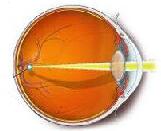Deprivation Myopia (DM)
Near-sightedness; Short-sightedness; Refractive error

Myopia is a refractive defect of the eye, is a condition of the eye where light focuses in front of, instead of on, the retina. This causes distant objects to be blurry while close objects appear normal. Other symptoms may include headaches and eye strain. Severe near-sightedness increases the risk of retinal detachment, cataracts, and glaucoma. The underlying cause is believed to be a combination of genetic and environmental factors. The underlying mechanism involves the length of the eyeball being too long or less commonly the lens being too strong. It is a type of refractive error. Several models for deprivation myopia were developed to study the mechanisms underlying refractive error. Using animal models, it was found that the visual environment exerts a powerful influence on refractive state by controlling the axial length of the eye during the postnatal developmental period.
Organism species: Mus musculus (Mouse)
- Disease model DSI576Mu01 Mouse Model for Deprivation Myopia (DM) In Stock
- Disease model DSI576Mu02 Mouse Model for Deprivation Myopia (DM) In Stock
- Customized Service n/a Tissue of Deprivation Myopia (DM) (If Necessary) Tissue Customized Service Offer
- Customized Service n/a Serums of Deprivation Myopia (DM) (If Necessary) Serums Customized Service Offer
Organism species: Rattus norvegicus (Rat)
- Disease model DSI576Ra01 Rat Model for Deprivation Myopia (DM) In Stock
- Disease model DSI576Ra02 Rat Model for Deprivation Myopia (DM) In Stock
- Customized Service n/a Tissue of Deprivation Myopia (DM) (If Necessary) Tissue Customized Service Offer
- Customized Service n/a Serums of Deprivation Myopia (DM) (If Necessary) Serums Customized Service Offer
Organism species: Cavia (Guinea pig )
- Disease model DSI576Gu01 Cavia Model for Deprivation Myopia (DM) In Stock
- Disease model DSI576Gu02 Cavia Model for Deprivation Myopia (DM) In Stock
- Customized Service n/a Tissue of Deprivation Myopia (DM) (If Necessary) Tissue Customized Service Offer
- Customized Service n/a Serums of Deprivation Myopia (DM) (If Necessary) Serums Customized Service Offer
Organism species: Oryctolagus cuniculus (Rabbit)
- Disease model DSI576Rb01 Rabbit Model for Deprivation Myopia (DM) In Stock
- Disease model DSI576Rb02 Rabbit Model for Deprivation Myopia (DM) In Stock
- Customized Service n/a Tissue of Deprivation Myopia (DM) (If Necessary) Tissue Customized Service Offer
- Customized Service n/a Serums of Deprivation Myopia (DM) (If Necessary) Serums Customized Service Offer
Organism species: Rhesus monkey (Simian)
- Customized Service n/a Model for Deprivation Myopia (DM) Disease Model Customized Service Offer
- Customized Service n/a Tissue of Deprivation Myopia (DM) (If Necessary) Tissue Customized Service Offer
- Customized Service n/a Serums of Deprivation Myopia (DM) (If Necessary) Serums Customized Service Offer
Organism species: Canis familiaris; Canine (Dog)
- Disease model DSI576Ca01 Canine Model for Deprivation Myopia (DM) In Stock
- Disease model DSI576Ca02 Canine Model for Deprivation Myopia (DM) In Stock
- Customized Service n/a Tissue of Deprivation Myopia (DM) (If Necessary) Tissue Customized Service Offer
- Customized Service n/a Serums of Deprivation Myopia (DM) (If Necessary) Serums Customized Service Offer


